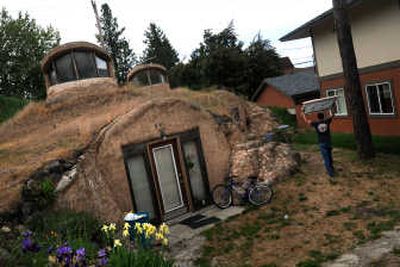Cheney boasts homes fit for hobbits

CHENEY – If Frodo Baggins ever moved to Cheney, he’d be quite comfortable living at 601, 603 or 605 Clay Street just down the hill from Centennial Park.
Frodo, the hobbit protagonist of J.R.R. Tolkien’s “The Lord of the Rings,” would recognize these unusual earth-shelter dome homes as very similar to the hobbit holes described in the story. So alike are they that students from nearby Eastern Washington University, who are the usual renters of the dwellings, refer to them as Cheney’s Hobbit Houses.
There are three of them, all one-room subterranean domes (only the bathroom is enclosed by walls) – the first is a 530-square-foot, 26-feet-across dome with one alcove. It has a loft and a see-through bubble on top that emerges through the dirt. The other two are each 650 square feet, 24 feet across, with three alcoves and vertical glass “windows” popping up from the dirt, with a kitchen window on the side.
They were the brainchild of Barry Elquest, a general contractor from Pullman who specialized in active and passive solar dwellings. When his daughter, Joie (Elquest) Storms, earned a volleyball scholarship to EWU in 1983, he traded some land in Pullman for the lots in Cheney and built the first structure for her. She lived there until she graduated in 1987.
“Looking at all the ways to build a better house, it’s obvious that standing sticks up in the air isn’t practical,” Elquest said. “But concrete in the dirt works pretty well.”
After completing the first earth shelter for Joie, he built the other two in the mid-1980s, making some modifications for greater efficiency, such as installing stucco and concrete frontal exteriors rather than the wood frame entrance he constructed for the prototype and modifying the dome to incorporate vertical glass panes, which cuts down on leaking problems.
Essentially, he blew up large balloons, overlaid them with chicken wire, sand and cement, creating a feral cement shell. Steel was placed on top, “and then we gunnited them,” Elquest said. “They’re pretty much upside-down swimming pools.” Dirt was placed on top to finish them off.
The advantages are that they’re bulletproof, fireproof and virtually soundproof, as well as being taxed at half the rate of regular homes because they’re listed as basements, said Elquest, who has been a full-time RVer for the past 16 years. He owns property in Colville and may make a home base there one of these days, he said.
Elquest had a lot of fun building the houses, including constructing retaining walls out of tires, nailing chicken wire on them and stuccoing them. “When you fill a tire with dirt, you get a 300-pound brick that’s free,” he said.
The people who live there love them. Tye Clinton, 33, a computer game design student at EWU, lives in the original structure. “With six feet of dirt between me and the next house, this place is soundproof,” he said. “Loud music is no problem. Sometimes I can hear the garbage truck outside, but that’s about all.”
But there are some interesting acoustic effects. In one of the other dome structures, a radio is turned on and the volume set at a normal level. Walking to the other side of the building, the sound becomes much louder.
The structures maintain close to a 70-degree temperature. Sunlight hitting the glass by the front doors heats the concrete, but there is electric heat available for the coldest of cold days. The structures are prone to moisture, so there are dehumidifiers running most of the time. There are interior shades for two of the skylights, and the original one is covered with a tarp (to keep nosy neighbors from peeking in). Because of the cement and all the dirt above, cell phones only work well when used underneath the skylights.
And the Hobbit Houses are something of a tourist attraction. Students participating in EWU’s Asia University America Program tend to come by and pose for pictures in front of them. Clinton has had people knock on his door to ask about the domes.
When Cheney resident Richard McDonnell, a retired schoolteacher who owns a number of rentals in the area, bought the structures in 2005, he did so “kind of as a joke. I thought they’d be fun, and they have been.”
McDonnell often meets friends and neighbors for coffee at Zip’s in the mornings. “Then on some days, I get up out of the booth and tell everybody that I’ve got to go and mow my roofs,” he said.
Frodo would be pleased.